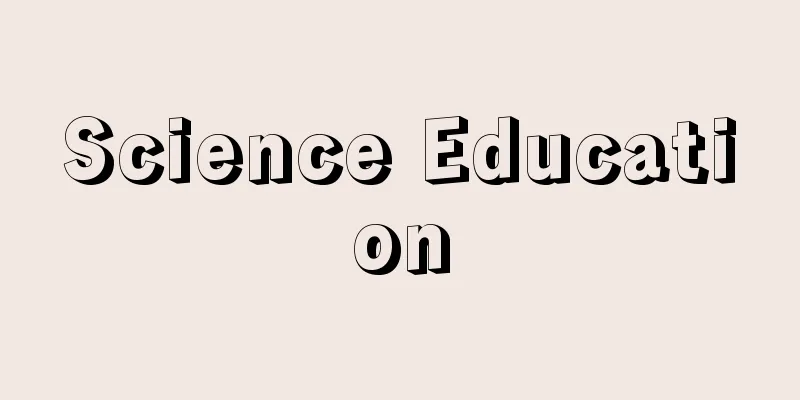Science Education

|
Among various educational activities, science education in the usual sense refers to activities that aim to provide a scientific understanding of natural phenomena and human culture and society. Generally, educational activities are centered on natural science, but today there is a strong demand for a social science approach. Such science education can be broadly divided into that provided within school education and that provided within social education, but both can also be further divided into that provided for the purpose of general education and that provided for the purpose of training professional experts. Places where science education is conducted in an organized and planned manner include school education, corporate education, etc. There are many forms of science education in social education, such as those conducted in various cultural facilities such as museums and community centers, as well as through mass communication such as television, radio, and newspapers, and through various publications such as books and magazines. [Kimura Yoshiyasu] Functions and RolesScience education is based on the natural sciences, which are a part of human cultural heritage. Therefore, science education is based on the scientific method of understanding nature that has been cultivated through research in the natural sciences, and on the scientific knowledge that is the product of these methods. It is expected that all people will acquire these skills and knowledge as part of their general education, and that this will help improve real life, and that science will be able to contribute to leading better human lives. Furthermore, basic education for the general public is expected to enable them to make decisions in various situations with a scientific attitude, and to use scientific knowledge effectively as an important basis for such decisions. On the other hand, it is also an important task for science education to contribute to the maintenance and development of the various sciences, particularly the natural sciences, and to train experts in this field. [Kimura Yoshiyasu] historySince the Renaissance, natural science has played an important role in Western culture, society, and real life. Until the mid-19th century, science was used to explain Christian doctrine and was well received, but the theory of evolution presented in the Heliocentric theory and Darwin's On the Origin of Species (1859) shook the foundations of Christian cosmology, worldview, and human view, and brought about open resentment and disgust on the part of Christians. In addition, the dominant educational tradition placed the education of humanities subjects, mainly classical languages, at the core of school education, making it extremely difficult to introduce modern science, which is based on experiment and verification, as typified by Galileo Galilei's experimental physics, into school education. Philosophically, ideas about science education were already expressed in the early 17th century. For example, the Italian Campanella envisioned science education for all residents in his work The City of the Sun (1623), which depicts an ideal communist state. Also, Comenius envisioned the introduction of natural science education into the school curriculum in his Large Didactic (1657). Rousseau and Pestalozzi, who are known as the people who preached the general principles of education today, believed that science is not something that should be taught, but something that students create through their own research. In particular, Rousseau's idea, expressed in "Emile" (1762), that "Do not teach the child science, let him create it" is still regarded as the golden rule for science teaching today. Friedrich Adolf Diesterweg (1790-1866), who is said to have demonstrated the ideal of heuristic teaching methods in science education, and the educators he and others around him developed a theory of elementary science education based on Pestalozziism and on the principles of children's self-activity, intuition, and discovery. Also, starting from the importance of the role that natural science plays in today's society, culture, and real life, it was Tyndall, T. H. Huxley, and H. Spencer in England who enlightened and developed the necessity of science education as a general education in this connection. This was in the 1860s and 1870s. The British chemist H. E. Armstrong (1848-1937) attempted to embody their distinctive empirical approach to science education in an even more remarkable way. His science education was called "discovery teaching" or "laboratory teaching", and he built the foundation for today's experiment-centered science education. In the early 20th century, Dewey, a prominent American educational philosopher and thinker, emphasized the importance of scientific methods in solving social problems in his works such as "School and Society" (1900) and "How We Think" (1910), and developed a theory of science education from the standpoint of science being useful for building a democratic society, with a focus on improving people's lives. His theory of science education had a strong influence on science education around the world until the 1950s, providing a theoretical foundation for "general science" as science education in primary schools and lower secondary schools. In the United States, it was linked to the project method and became a major educational movement. [Kimura Yoshiyasu] Reforming the science education curriculumThrough experiences such as the Industrial Revolution and the First and Second World Wars, science education has developed in close connection with technology, industry, and the military industry. In particular, the launch of the Soviet artificial satellite Sputnik in 1957 shocked America and became the catalyst for large-scale reform of science education curricula. The enactment of the National Defense Education Act (NDEA) in 1958 clearly demonstrates the close connection between strengthening national defense and science education. In the United States, science curriculum reform, which began at the upper secondary education stage, was carried out on a large scale with the support of the National Science Foundation (NSF) and various private foundations, and produced many curricula closely related to modern natural sciences and mathematics. This movement spread to European countries, and in the UK, the Nuffield Science Curriculum was produced from primary to upper secondary education with financial support from the Nuffield Foundation. It also strongly encouraged science curriculum reform in many countries, including Japan. The series of science curriculum reforms were developed mainly by university researchers in natural sciences, and the contents of the developed curricula emphasized the main basic concepts of modern natural science and scientific methods, and did not place importance on the position of science in society. This reform movement spread to the elementary school level, and produced a scientistic elementary science curriculum based on the findings of psychologists such as Piaget and the assumption summarized by Bruner that "any subject can be taught effectively to any child at any stage of development while maintaining its intellectual character." The developed elementary science curriculum placed children's activities at the center, and teaching goals were described as "behavioral goals." This series of science curricula were not born from the field of education and were too scientific, so the reforms could not be said to have been a complete success. However, the organization and strategies for science curriculum development became important legacies and served as models for subsequent curriculum reforms. The movement for science curriculum reform that began in the 1950s and continued through the mid-1970s was a truly major global activity. The background that made this science curriculum reform movement possible was the unprecedented development of the world economy. However, with the subsequent stagnation of the world economy, enthusiasm for reform has rapidly waned. [Kimura Yoshiyasu] Future RoleWith the remarkable progress of science and technology, humanity has solved many problems up to now. However, since the 1970s, the deterioration of the environment on the earth's surface has become global in scale, and we are being asked to solve important issues that affect the survival of humanity, such as securing energy, food crises, responding to population growth, appropriate use of nuclear energy, and ethics regarding life as seen in genetic modification. Moreover, all of these issues are complex problems that cannot be solved by the decision-making of a few people, and truly require the wisdom of humanity. Science education reform based on this recognition has already begun, creating a trend toward integrating, interdisciplinary, and humanizing science curricula. International organizations such as UNESCO and OECD (Organization for Economic Cooperation and Development) have also begun to make active efforts to develop and implement integrated science curricula. At the same time, research into how to incorporate this type of integrated science curriculum into school education has also become a necessary task. Science education is also expected to play an important role not only in school education, but also in social education and lifelong education in general. [Kimura Yoshiyasu] "Kimura, Masayasu (ed.), "Principles of Science Education" (1973, Meiji Tosho Publishing)" ▽ "School Science Research Association (ed.), "Science Education Around the World" (1982, Mizuumi Shobo) " ▽ "Morikawa, Hisao (ed.), "Educational Studies Lectures 12: Theories and Structures of Science Education" (1979, Gakken)" [References] | | | | | | | | |Source: Shogakukan Encyclopedia Nipponica About Encyclopedia Nipponica Information | Legend |
|
諸教育活動のなかで、自然事象や人間の文化・社会を科学的に理解させようとする活動が通常の意味における科学教育である。一般には、自然科学を中心とした教育活動をさすが、今日では社会科学的なアプローチも強く求められている。 このような科学教育は、学校教育のなかで行われるものと、社会教育のなかで行われるものに大別できるが、さらに、それらはいずれも一般教養を目的として行われるものと、職業的な専門家の育成を目的として行われるものとに区別することができる。 科学教育が組織的、計画的に行われる場としては、学校教育や企業内教育などがある。社会教育のなかで行われる科学教育の形態としては、博物館、公民館などの各種文化施設において行われるもののほかに、テレビ、ラジオ、新聞などのマスコミュニケーションによるもの、書物、雑誌などの各種刊行物によるものなど数多くある。 [木村仁泰] 機能と役割科学教育は、人間の文化遺産のなかでもとくに自然科学に基礎を置いている。そのため、科学教育は、自然科学研究が培ってきたところの自然認識の科学的方法、およびそれらの所産としての科学的知識に基づいている。すべての人々が一般教養としてこれらの技能や知識を身につけ、それによって実生活の改善に役だて、よりよい人間生活を営むために、科学が貢献できることが期待されている。また種々な場面での意志決定を科学的態度で行い、その重要な論拠として科学的知識が有効に働くことが、一般市民の基礎教養として求められている。他方では、自然科学を中心とする諸科学の維持と発展に科学教育が貢献し、その専門家を養成することも重要な課題である。 [木村仁泰] 歴史ルネサンス以降、西欧の文化、社会、実生活において自然科学は重要な役割をもつようになってきた。19世紀中ごろまでの科学は、キリスト教の教義の説明にも用いられ、好意的に迎えられたが、「地動説」やダーウィンの『種の起原』(1859)に示された進化論は、キリスト教的宇宙観、世界観、人間観の立脚点を揺るがし、キリスト教側のあからさまな反感と嫌悪感をもたらした。これに加えて、古典語を主とした人文的教科の教育をもって学校教育の中核とする教育伝統が支配的であったため、ガリレオ・ガリレイの実験物理学に代表される実験・実証を基礎とする近代科学を学校教育のなかに導入することは困難を極めた。 思想的には、すでに17世紀の初頭に科学教育に関する考え方が示されている。たとえば、イタリアのカンパネッラは、共産的理想国家を描いた『太陽の都』(1623)のなかで、全住民に対する科学教育を構想した。またコメニウスは『大教授学』(1657)において、学校カリキュラムへ自然科学教育を導入することを構想している。 今日の教育の一般的原理を説いた人物として知られているルソーやペスタロッチは、科学は教えられるべきものではなく、生徒が自らの研究を通して創造していくものであると考えた。とくに『エミール』(1762)に示されたルソーの「子供に科学を教えるな、彼にそれを創造させよ」という考え方は、現在においても科学教授の黄金律として評価されている。 科学教育の発見的教授法の理念を示したといわれるディースターベークFriedrich Adolf Diesterweg(1790―1866)と、彼を中心とした教育者たちは、ペスタロッチ主義に基づき、子供の自己活動・直観・発見を原則とする初等科学教育論を展開した。 また自然科学が今日の社会、文化、実生活において果たしている役割の重要性から説き起こし、それとの関連で一般教育としての科学教育の必要性を啓蒙(けいもう)し発展させたのが、イギリスにおけるチンダル(ティンダル)であり、T・H・ハクスリーであり、H・スペンサーであった。それは1860~1870年代のことである。彼らの顕著な生活経験主義的立場にたった科学教育を、さらに際だった形で具体化しようとしたのが、イギリスの化学者アームストロングH・E・Armstrong(1848―1937)であった。彼の科学教育は「発見的教授法」または「実験室教授法」とよばれ、今日の実験を中心とする科学教育の基礎を築いた。 20世紀初頭、アメリカの優れた教育哲学者・思想家であるデューイは、『学校と社会』(1900)、『われわれはいかに思考するか』(1910)などの著作のなかにおいて、社会問題の解決に果たす科学の方法の重要性を強調し、生活の改善を中心とした、民主主義社会の建設に有用な科学という立場での科学教育論を展開した。彼の科学教育論は、その後1950年代ごろまで、世界の科学教育に強い影響を与え、初等科学教育や前期中等学校における理科教育としての「一般理科」general scienceに理論的基礎を与えた。アメリカにおいては、それはプロジェクト・メソッドと結び付き、一大教育運動となった。 [木村仁泰] 科学教育カリキュラムの改革科学教育は、産業革命や第一次・第二次世界大戦などを経験することによって、技術、工業、軍事産業などと密接な関連をもって発展してきた。とくに1957年のソ連の人工衛星スプートニクの打上げはアメリカを震撼(しんかん)させ、科学教育カリキュラムの改革を大規模に促進させる起爆剤となった。全米防衛教育法(略称NDEA:National Defense Education Act)の成立(1958)は、国家防衛力の強化と科学教育との密接な関連を如実に物語るものである。 後期中等教育段階に始まる科学カリキュラム改革は、アメリカにおいては、全米科学財団(略称NSF:National Science Foundation)や各種の私設財団の援助のもとに大規模に展開され、現代自然科学や現代数学と密接に関連したカリキュラムを数多く生み出した。この動きはヨーロッパ諸国にも波及し、イギリスにおいては、ナフィールド財団の資金援助によって初等から後期中等教育に至るナフィールド科学カリキュラムを生み出した。さらに日本を含む多くの国々の科学カリキュラム改革を強く促す結果となった。 一連の科学カリキュラム改革は、大学の自然科学研究者を中心として展開されたために、開発された諸カリキュラムの内容は、現代自然科学の主要な基礎概念と科学の方法とを強調したものとなり、社会における科学の位置づけは重視されなかった。この改革の動きは初等段階にも波及し、ピアジェらの心理学者の知見や、ブルーナーによってまとめられた「どの教科でも知的性格をそのままに保って、発達のどの段階のどの子供にも効果的に教えることができる」という仮定に基づいて、科学主義的な初等科学カリキュラムを生み出した。開発された初等科学カリキュラムは児童の活動を中心に置き、指導目標は「行動目標」として記述された。 これらの一連の科学カリキュラムは、教育現場のなかから生まれたものでなかったことや、あまりにも科学主義的であることなどのために、改革は完全な成功を収めたとはいえなかった。しかし科学カリキュラム開発の組織・開発の方略などは重要な遺産となり、以後のカリキュラム改造のモデルとなった。1950年代から始まり、1970年代のなかばにかけての科学カリキュラム改革の動きは、まさに世界的に大きな活動であった。このような科学カリキュラム改革運動を可能にした背景は、これまでに比類のない世界経済の発展であった。しかし、その後の世界経済の停滞とともに改革の熱意も急速に衰えてきている。 [木村仁泰] 今後の役割科学技術の目を見張るような進展に伴い、人類は今日までいろいろな問題を数多く解決してきた。しかし、1970年代以降、地表における環境の悪化は、地球的規模となり、エネルギーの確保、食糧危機、人口増大への対応、原子核エネルギーの適切な利用、遺伝子組換えなどにみられる生命に対する倫理など、人類の生存にかかわる重大な事項がわれわれに解決を求めてきている。しかもいずれの問題も一部の人々による意志決定では解決できない複合的な問題であり、まさに人類の英知が求められている。こういった認識に基づいた科学教育改革はすでに始められ、科学カリキュラムの総合化、学際化、人間主義化という傾向を生んでいる。ユネスコやOECD(経済協力開発機構)などの国際機関も総合的科学カリキュラムの開発とその実施に向けて積極的な努力を始めている。さらに、この種の総合的科学カリキュラムを学校教育のなかにどのように組み込んでいくかの研究も、同時に必要な課題となっている。また科学教育は、学校教育のなかだけでなく、広く社会教育や生涯教育のなかでも重要な役割を果たすことが期待されている。 [木村仁泰] 『木村仁泰編著『理科教育学原理』(1973・明治図書出版)』▽『学校理科研究会編『世界の理科教育』(1982・みずうみ書房)』▽『森川久雄編著『教育学講座12 理科教育の理論と構造』(1979・学習研究社)』 [参照項目] | | | | | | | | |出典 小学館 日本大百科全書(ニッポニカ)日本大百科全書(ニッポニカ)について 情報 | 凡例 |
>>: Science and Technology Agency
Recommend
《Oranda Shisei Erekiteru Kyurigen》 - Oranda Shisei Erekiteru Kyurigen
...Afterwards, Morishima Churyo (1756-1810), Taka...
Himalayan cedar
An evergreen coniferous tall tree of the Pinaceae...
Poncho - Poncho (English spelling) poncho Spanish
Originally, it was an outer garment worn by the i...
Kanagawa-juku
…In 1395 (Oei 2), Kanagawa-go was granted to Uesu...
Dust explosion
Also called a powder explosion. A violent explosio...
Oribe ware
Creative pottery fired in Mino kilns in the easte...
Diary of the Two Butterflies
Joruri Gidayubushi. Sewamono (domestic drama). Ni...
common benefit
...Since ancient Greece, it has been one of the f...
Trail - Miracle
A figure F formed by a set of points that satisfy...
Tyto alba (English spelling) Tytoalba
...A general term for birds in the Tytonidae fami...
Joel Stebbins
1878‐1966 American astronomer. Born in Nebraska, h...
Kirikosha (English name) jì lǐ gǔ chē
Since the Jin Dynasty (265-420) in China, this was...
low moor
...fens are broadly divided into mineralotrophic ...
Quartz Clock - Quartz Clock
A clock that uses an oscillator that utilizes the...
Utrecht Psalter - Utrecht Psalter
This illustrated manuscript is thought to have bee...









